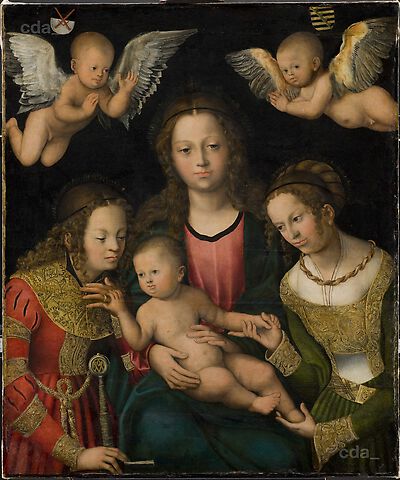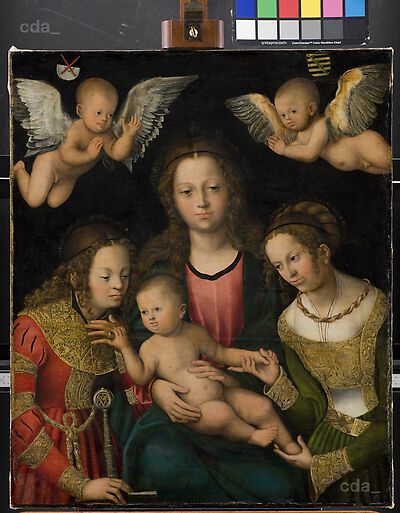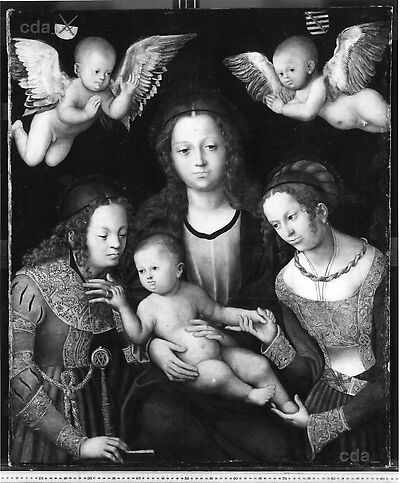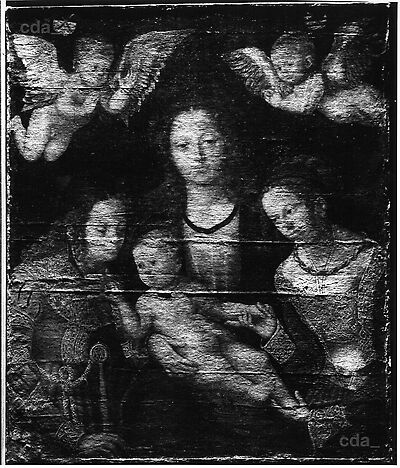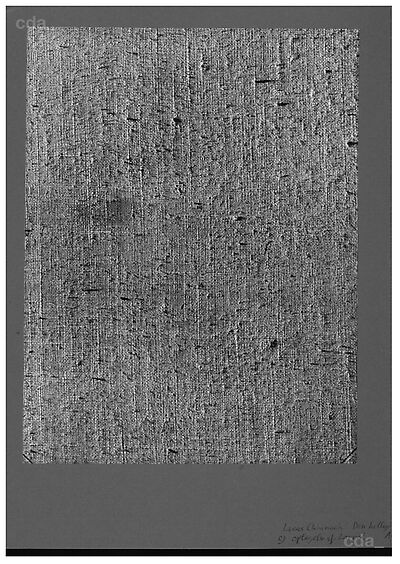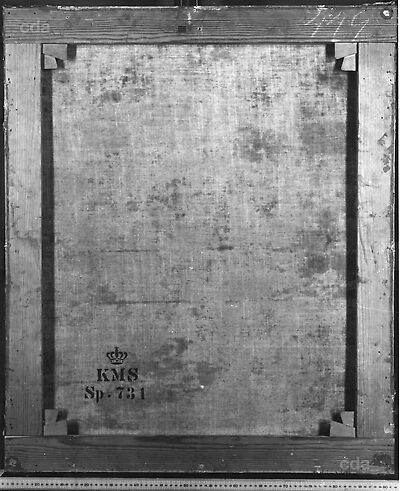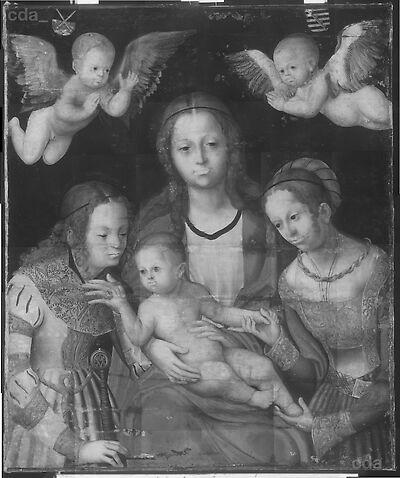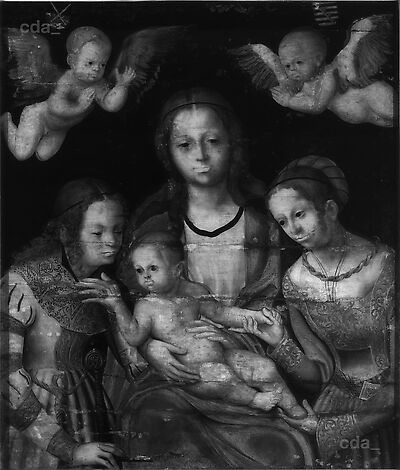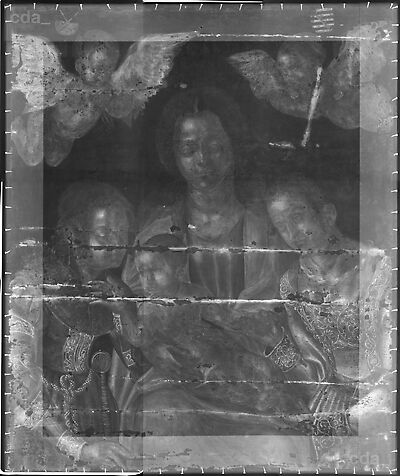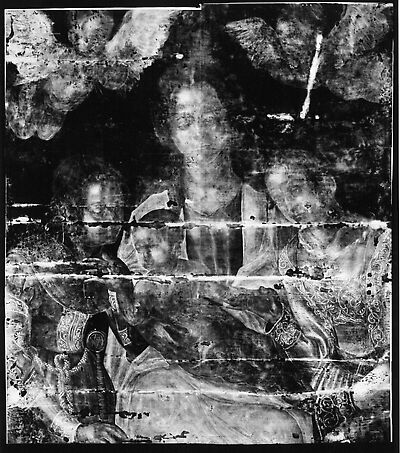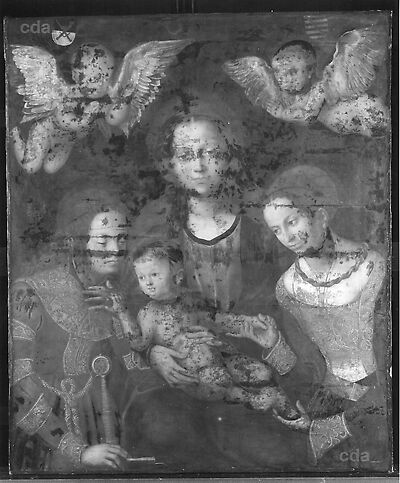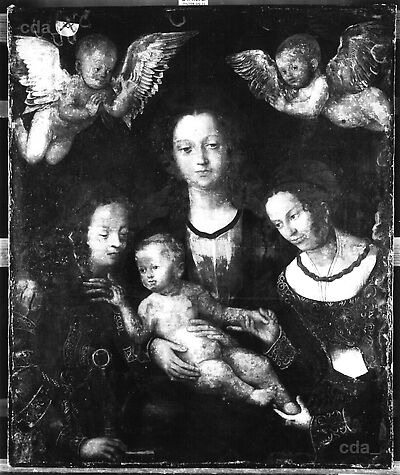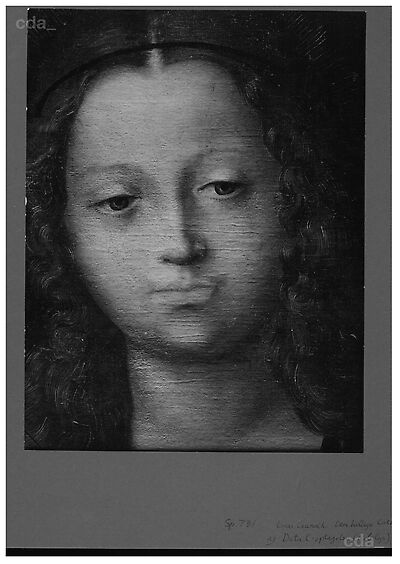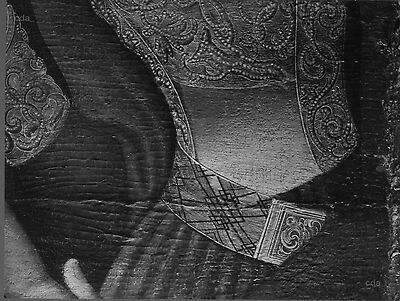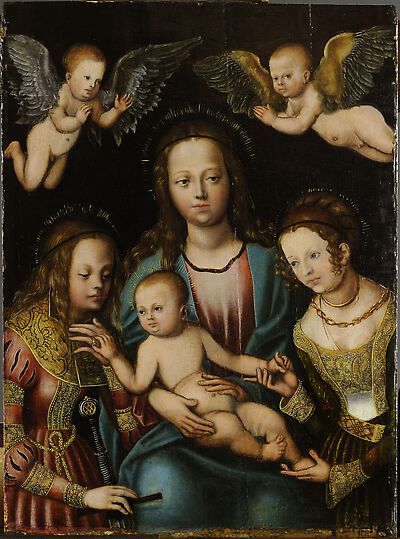Eine mögliche Zusammengehörigkeit der beiden Werke [DK_SMK_KMSsp730] innerhalb eines Altarprogramms wurde in der Forschung kontrovers diskutiert: so sprechen ungeachtet des annähernd gleichen Formates der Täfeln, die erst seit dem 18. Jahrhundert gemeinsam in der Königlichen Sammlung in Kopenhagen verwahrt werden, deren unterschiedlicher Figurenmaßstab, stilistische Abweichungen und die verschiedenartigen Bildgründe gegen eine originäre Verbindung. [1] Das Mittelbild weist enge Anbindung an den etwas großformatigeren sogenannten 'Fürstenaltar' aus Dessau (um 1510) auf, der vermutlich für die Marienkapelle der wittenberger Schlosskirche entstand und die Kopenhagener Tafel kompositorisch, motivisch und stilistisch sowie im Bildtypus der halbfigurigen Gottesmutter mit Heiligen vorwegnimmt. [2] Die heitere Ausstrahlung des Bildes ist dort einem feierlichen Ernst gewichen. [3] Die Dessauer Seitenflügel zeigen neben Herzog Johann den Beständigen von Sachsen auf der linken Seite, der in gleichem Habitus wie in Kopenhagen, hier allerdings vor schwarzem Grund und in Begleitung des Heiligen Bartholomäus erscheint. Eine ähnlich deutliche Verwandtschaft zur Kopenhagener Mitteltafel wurde auch für das kriegszerstörte Bild einer 'Madonna mit Kind und den Heiligen Margareta, Katharina, Barbara und Dorothea' (um 1512-1514) [DE_smbGG-Lost_NONE-001] festgestellt, das wiederum in Einzelmotiven wie der Pose und Wendung des Kindes, dem Anstecken des Ringes und den Gesten der Heiligen Barbara dem erstgenannten Werk noch näher steht als das Bild in Dessau: [4] Stil und Format, vor allem jedoch der Landschaftshintergrund, dessen für Cranach untypische Himmelsgestaltung wohl eine Schülerhand verrät, ließen die Forschung in der ehemaligen Berliner Tafel das Pendant zum Kopenhagener Stifterflügel vermuten. [5] Für den Typus des Madonnenbildes wurde mit unterschiedlicher Überzeugungskraft der Einfluss niederländischer und italienischer Bildkunst sowie das Vorbild Albrecht Dürers diskutiert. [6] Während der Gesichtstypus Mariens der bei Cranach zwischen 1500 und 1510 üblichen weiblichen Physiognomie entspricht, wie sie u. a. in der St. Petersburger 'Venus' (1509) zum ausdruck kommt, [7] wurde für die Frauenköpfe des Seitenflügels eine Verwandtschaft mit den Heiligenfiguren des Dresdner 'Katharinenaltars (1506) beobachtet. [8]
Die Übereinstimmungen zwischen den genannten Altar-Werken [9] und den Kopenhagener Bildern liefern nicht nur einen Eindruck von deren ursprünglichem Zusammenhang, sie demostrieren zugleich exemplarisch die für die frühe Altarproduktion Cranachs charakteristische Verwertung eines etablierten Motivrepertoires, dessen vorlagen sich teilweise auch aus grafischen Arbeiten des Künstlers speisten. [10]
[1] Friedländer, Rosenberg 1979, 76, No. 36; Exhib. Cat. copenhagen 2002, 91, Nos. 12 und 13; Exhib. Cat. Hamburg 2003, 167, Nos. 4 und 4a.
[2] Flechsig 1900, 85f.; Friedländer, Rosenberg 1979, 72, No. 20; Cat. Dessau 1996, 23-25, No. 7.
[3] Exhib. Cat. Hamburg 2003, 167, No. 4a
[4] Friedländer, Rosenberg 1979, 76, No. 37; Erichsen 1994, 164, Fn. 4; Exhib. Cat. Hamburg 2003, 167, No. 4
[5] Ebenda. eine Kopie des Berliner bildes befindet sich im tschechischen Jáchymov (Sankt Joachimsthal). Erichsen 1994, 157.
[6] Schade 1974, 38-40; Friedländer, Rosenberg 1979, 72, No. 20; Cat. Dessau 1996, 24.
[7] Exhib. Cat. Hamburg 2003, 167, No. 4a.
[8] Friedländer, Rosenberg 1979, 68f., Nos. 12-15 und S. 76, No. 36
[9] Weitere Madonnentafeln mit einer Darstellung der Katharinenlegende befinden sich in Dessau (1516) [DE_AGGD_10] und Budapest (um 1516-18) [HU_SMB_133]. Friedländer, Rosenberg 1979, 87, Nos. 85 und 85
[10] Erichsen 1994, 156-161
[Carrasco, Exhib. Cat. Gotha, Kassel 2015, 102, 103, Nos. 6, 7]
